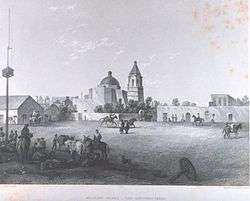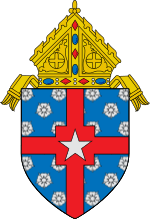Claude Marie Dubuis
Claude Marie Dubuis (March 10, 1817 – May 22, 1895) was a French-born prelate of the Roman Catholic Church. Dubuis learned English, Alsatian, and Spanish in order to tend his diverse flock. He served as the second Bishop of Galveston from 1862 to 1892. Unable to obtain women religious from American communities to care for the many sick and orphaned, he founded the Sisters of Charity of the Incarnate Word.
Early life
Dubuis was born 10 March 1817 to François and Antoinette (Dubost) Dubuis, in Coutouvre, Loire, where he was raised on his parents' farm. At the age of ten years old, he was sent to live with his maternal uncle, the abbé Dubost, a pastor in a nearby town, in the expectation that the abbé would sufficient train Dubuis fot entrance to the seminary. He learned Latin, but in 1833, when Dubuis entered L'Argentière, a preparatory seminary, it became apparent that his education was lacking, particularly in a knowledge of Greek. After six months of frustration, he withdrew from the seminary, and returned to his home in Teche, where he worked as a day laborer for a time before deciding to become a missionary. At his mother's suggestion, he asked Dubost for help and was directed to a tutor in a nearby village named Fouilland. Fouilland taught Dubuis Latin, Greek, and French grammar for eight months. He entered St. Jodard, a minor seminary, where he passed all of his courses without difficulty. He then returned to L'Argentière, where in his second year he served as infirmarian. He was later graduated with honors. By 1840 he had entered the major seminary of St. Irenaeus at Lyons.[1]

On June 1, 1844, at the age of twenty-seven, Dubuis was ordained a priest at Lyon.[2] His first assignment was at Lyons, where in 1846 he met Bishop Jean Marie Odin, apostolic vicar for Texas, who had returned to France to recruit religious to work in Texas. The Texas mission was supported by the Society for the Propagation of the Faith, but was generally short of both funds and missionaries. Dubuis, set sail from Le Havre in March of that year with a small group of fellow recruits. After arriving in New Orleans, they were sent first to the St. Mary's of the Barrens, a Vincentian Seminary in Perryville, Missouri, to learn English.[1]
Texas
Pastor
Father Dubuis arrived in Texas during the winter of 1847, and was assigned as pastor of Castroville, where many of the residents were German or Alsatian immigrants. There he found a very small church and a crude hut that had been used by a former priest. He immediately set to work learning the Alsatian language. With the help of his assistant, Father Matthew Chazelle, they started building a new house. Dubuis opened a school, teaching some eighty youngsters within the first year. His energy and disposition soon won him the affection of the people.[3]

That year Father Chazelle died of typhus and Father Emmanuel Domenech was sent to help Father Dubuis. The parish included the villages of D'Hanis, Vandenburg, Quihi, New Braunfels, and Fredericksburg. Dubuis tended his parish on foot or on horseback. On one occasion, he spent a night in a tree above surging floodwaters.[4] Dubuis often had to ride through hostile Comanche territory in order to carry out his duties and was captured four times by Indians. However, Castroville was not attacked; the Indians traded with the settlers, exchanging venison and turkey for sugar and other items. Sometimes they stopped by the church to hear the music.[5] By 1850, the small church was inadequate, and with the help of the men of the parish and Father Domenech, the second church was completed by Easter. This church was used for 20 years and later razed when the third and present church was finished.[3]
In 1850, Bishop Odin sent Dubuis to France for some needed rest and to recruit missionaries. When Dubuis left Castroville for San Antonio he left behind him a firmly established parish of St. Louis, as well as a church building and rectory built mainly by his own hands. He is credited with developing the architectural style distinctive to Castroville, which resembles that of Alsatian structures. Dubuis developed the cemetery and placed a cross on the hill next to the cemetery, following a tradition common in the villages of France. Since then it has been called Cross Hill and was used by the Catholics for more than 100 years for pilgrimages and prayer petitions, such as rogation days, to pray for successful crops of the farmers. The custom was discontinued in the 1950s.[3]
Upon his return from France in 1851, Dubuis was appointed pastor of the Church of San Fernando in San Antonio and vicar general of the Diocese of Galveston. A diverse community, announcements from the pulpit were made in English, French, German, and Spanish. Initially, Dubuis was not sufficiently conversant in Spanish to administer the last rites, and Bishop Odin stayed in San Antonio until a priest who spoke Spanish arrived to assist.[6]
Bishop
Archbishop Antoine Blanc, Archbishop New Orleans, died on June 20, 1860. On February 15, 1861 Bishop Odin was appointed his successor. Dubuis was one of three individuals Bishop Odin had recommended to succeed him in Galveston, all of whom spoke both English and Spanish, and knew the area. Dubuis went to New Orleans in June 1861 to improve his health, and planned to make a trip to France to recruit more missionaries. However, in April 1961 President Lincoln had ordered a blockade of Southern ports. Not having heard from the Holy See, Bishop Odin decided to go to Europe. In early 1862, Dubuis wrote a Texas colleague that he planned to run the blockade and leave for France in mid-April. Franklin C. Williams, Jr. is of the opinion that as Odin and Dubuis were both French Vincentians from the area of Lyons, that they probably sailed together. Some months later, Dubuis was appointed to succeed Bishop Odin as the second Bishop of the Diocese of Galveston.[7]
Dubuis was consecrated by Odin on November 23, 1862, in Lyons. In May 1863 he entered his episcopal city, where he worked for the next seventeen years.[1] Dubuis saw the diocese through the turmoil of the Civil War, after which he established additional parishes, hospitals and schools.[8] In September 1865, the Sisters of St. Joseph in New Orleans requested Archbishop Odin to send Bishop Dubuis to take confessions, as their usual confessor was unavailable and "Dubuis is so humble that he would come."[9]
1866 saw a rapidly spreading cholera epidemic. Unable to persuade the American religious congregations with trained nurses to establish a presence in Galveston, the bishop wrote to the Sisters of Divine Providence from St. Jean-de-Bassel near Nancy, Alsace, who agreed to come and work in healthcare. During his tenure as bishop he brought almost seventy religious into the state. On one of his trips to Europe, he secured the services of the Congregation of the Resurrection to minister to the Polish community in Texas.[10] He founded the Sisters of Charity of the Incarnate Word.[11] In 1873, at the Bishop's request, the Sisters of Notre Dame de Namur in Lockport, New York established the Academy of the Sacred Heart in Waco.[12]
He returned to Castroville as bishop to lay the cornerstone for the third Church of St. Louis. In 1866, Bishop Dubuis made his first episcopal visit, to what would become the Diocese of Corpus Christi, and returned the following year. As early as 1870 Bishop Dubuis, began sending Father Vincent Perrier twice a year to visit Fort Worth.[13] He also attended the First Vatican Council in Rome in 1869-1870. In 1874, the Diocese of Galveston was split when the western half of the State of Texas was established as the Diocese of San Antonio.[8]
Later life
In 1881 he retired to his native France due to poor health, leaving the management of the diocese to an administrator. He took up residence at Vernaison.[14] He resigned as Bishop of Galveston on December 16, 1892 and was named Titular Archbishop of Arca in Armenia on the same date.[2] He assisted Cardinal Pierre-Hector Coullié, the Bishop of Lyons, in episcopal work until his death on 22 May 1895.[14]
Legacy
Bishop Dubuis founded the Sisters of Charity of the Incarnate Word, a community that came to play a significant role in the provision of healthcare services in Texas.[15] They also established the University of the Incarnate Word.
References
- Foley, Patrick. "Dubuis, Claude Marie", Handbook of Texas Online
- "Bishop Claude Marie Dubuis". Catholic-Hierarchy.org.
- "Claude Marie Dubuis", Castroville Area Chamber of Commerce
- Jacks, L.V., Obisbo de Galveston, 1946
- The French in Texas: History, Migration, Culture, (François Lagarde, ed.), University of Texas Press, 2003 ISBN 9780292705289
- Matovina, Timothy M., Tejano Religion and Ethnicity: San Antonio, 1821-1860, University of Texas Press, 2010, p. 65, ISBN 9780292726550
- Williams, Jr., Franklin C., "The Appointment of Bishop Dubuis", East Texas Historical Journal, Vol.28, Issue 2, October 1990
- "History of the Archdiocese". Roman Catholic Archdiocese of Galveston-Houston. Archived from the original on 2003-11-10. Retrieved 2009-08-27.
- Sister M. Anatolie C.S.J to Archbishop Odin, CM. September 24, 1865; University of Notre Dame Archives
- Baker, T. Lindsay. The First Polish Americans: Silesian Settlements in Texas, Texas A&M University Press, 1996 ISBN 9780890967256
- McDonough IWBS, Kathleen. "Sisters of Charity of the Incarnate Word", South Texas Catholic, August 1, 2012
- Hunt, Geoff. "Academy of the Sacred Heart", Waco History
- "History", St. Patrick's Cathedral, Fort Worth
- Meehan, Thomas. "Galveston." The Catholic Encyclopedia Vol. 6. New York: Robert Appleton Company, 1909. 21 November 2017
- Neal, Allison Ward. "Founders of two Catholic health systems celebrate", South Texas Catholic, October 20, 2016
![]()
Episcopal succession
| Catholic Church titles | ||
|---|---|---|
| Preceded by Jean-Marie Odin |
Bishop of Galveston 1862–1892 |
Succeeded by Nicolaus Aloysius Gallagher |
